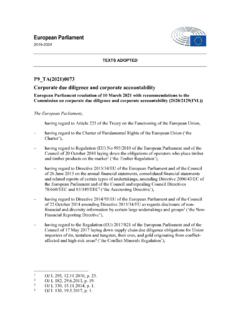Transcription of INTERPRETATION MANUAL OF EUROPEAN UNION HABITATS
1 INTERPRETATION . MANUAL . OF. EUROPEAN UNION . HABITATS . EUR 28. April 2013 . EUROPEAN commission . DG ENVIRONMENT. Nature ENV The INTERPRETATION MANUAL of EUROPEAN UNION HABITATS - EUR28 is a scientific reference document. It is based on the version for EUR15, which was adopted by the HABITATS Committee on 4. October 1999 and consolidated with the new and amended habitat types for the 10 accession countries as adopted by the HABITATS Committee on 14 March 2002. A small amendment to habitat type 91D0 was adopted by the HABITATS Committee in its meeting on 14th October 2003. The HABITATS Committee at its meeting on 13 April 2007 adopted additional changes for the accession of Bulgaria and Romania, and for the marine HABITATS , followed the descriptions given in Guidelines for the establishment of the Natura 2000 network in the marine environment.
2 Application of the HABITATS and Birds Directives . published in May 2007 by the commission services. Amendments for the accession of Croatia were adopted by the HABITATS Committee on 4 October, 2012. The April 2013 version consolidates the changes for Croatia in the text and corrects the references to EUNIS codes for three marine habitat types. TABLE OF CONTENTS. WHY THIS MANUAL ? 3. HISTORICAL REVIEW 3. THE MANUAL 4. THE EUR15 VERSION 5. THE EUR25 VERSION 5. THE EUR27 VERSION 6. THE EUR28 VERSION 6. EXPLANATORY NOTES 7. COASTAL AND HALOPHYTIC HABITATS 7. COASTAL AND HALOPHYTIC HABITATS 8. OPEN SEA AND TIDAL AREAS 8. SEA CLIFFS AND SHINGLE OR STONY BEACHES 17. ATLANTIC AND CONTINENTAL SALT MARSHES AND SALT MEADOWS 20. MEDITERRANEAN AND THERMO-ATLANTIC SALTMARSHES AND SALT MEADOWS 22. SALT AND GYPSUM INLAND STEPPES 24.
3 BOREAL BALTIC ARCHIPELAGO, COASTAL AND LANDUPHEAVAL AREAS 26. COASTAL SAND DUNES AND INLAND DUNES 29. SEA DUNES OF THE ATLANTIC, NORTH SEA AND BALTIC COASTS 29. SEA DUNES OF THE MEDITERRANEAN COAST 35. INLAND DUNES, OLD AND DECALCIFIED 37. FRESHWATER HABITATS 38. STANDING WATER 38. RUNNING WATER 44. TEMPERATE HEATH AND SCRUB 48. SCLEROPHYLLOUS SCRUB (MATORRAL) 58. SUB-MEDITERRANEAN AND TEMPERATE SCRUB 58. MEDITERRANEAN ARBORESCENT MATORRAL 60. THERMO-MEDITERRANEAN AND PRE-STEPPE BRUSH 61. PHRYGANA 63. NATURAL AND SEMI-NATURAL GRASSLAND FORMATIONS 65. NATURAL GRASSLANDS 65. SEMI-NATURAL DRY GRASSLANDS AND SCRUBLAND FACIES 70. SCLEROPHILLOUS GRAZED FORESTS (DEHESAS) 78. SEMI-NATURAL TALL-HERB HUMID MEADOWS 78. MESOPHILE GRASSLANDS 82. INTERPRETATION MANUAL - EUR28 Page 1. RAISED BOGS AND MIRES AND FENS 84. SPHAGNUM ACID BOGS 84.
4 CALCAREOUS FENS 89. BOREAL MIRES 92. ROCKY HABITATS AND CAVES 93. SCREE 93. ROCKY SLOPES WITH CHASMOPHYTIC VEGETATION 98. OTHER ROCKY HABITATS 102. FORESTS 103. FORESTS OF BOREAL EUROPE 103. FORESTS OF TEMPERATE EUROPE 109. MEDITERRANEAN DECIDUOUS FORESTS 131. MEDITERRANEAN SCLEROPHYLLOUS FORESTS 136. TEMPERATE MOUNTAINOUS CONIFEROUS FORESTS 140. MEDITERRANEAN AND MACARONESIAN MOUNTAINOUS CONIFEROUS FORESTS 142. INTERPRETATION MANUAL - EUR28 Page 2. WHY THIS MANUAL ? Historical review The " HABITATS " Directive1 is a Community legislative instrument in the field of nature conservation that establishes a common framework for the conservation of wild animal and plant species and natural HABITATS of Community importance; it provides for the creation of a network of special areas of conservation, called Natura 2000, to "maintain and restore, at favourable conservation status, natural HABITATS and species of wild fauna and flora of Community interest".
5 Animal and plant species names are clearly presented in the Directive and, despite minor misspellings or use of synonyms, no major additional work needs to be done to allow a correct INTERPRETATION of Annex II. In contrast, the development of a common agreed definition appeared to be essential for the different habitat types of Annex I. Annex I lists today 233 EUROPEAN natural habitat types, including 71 priority ( habitat types in danger of disappearance and whose natural range mainly falls within the territory of the EUROPEAN UNION ). Annex I was initially based on the hierarchical classification of EUROPEAN HABITATS developed by the CORINE Biotopes project 2 since that was the only existing classification at EUROPEAN level. A draft list of habitat types for Annex I was therefore drawn up on the basis of this classification by Professor A.
6 Noirfalise and submitted to the national experts preparing the Directive as a working document in August 1989. Numerous discussions with the national experts then took place between 1989 and 1991, culminating in the version of Annex I. published in the Official Journal in May 1992. In December 1991, while the Directive was being adopted, a thorough revision of the CORINE classification was published 3. This revision introduced numerous changes within codes and habitat types, in particular involving the division of the latter into sub-types. Definitions had been prepared for the various categories. Consequently, the Annex I codes no longer corresponded fully to the codes and descriptive content of the various categories of CORINE, resulting in considerable ambiguities in the INTERPRETATION of Annex I on the basis of the CORINE classification.
7 The Task Force/ EUROPEAN Environment Agency thus produced a paper establishing the correspondence between the habitat codes of Annex I and those of the 1991 version of the CORINE classification 4. This paper also included the description proposed in the 1991 CORINE version for the various habitat types of Annex I. 1. Council Directive 92/43/EEC of 21 May 1992 on the conservation of natural HABITATS and of wild fauna and flora, L206, 2. CORINE Biotopes - Technical Handbook, volume 1, p. 73-109, Corine/ , 19 May 1988, partially updated 14. February 1989. 3. CORINE Biotopes MANUAL , HABITATS of the EUROPEAN Community. EUR 12587/3, Office for Official Publications of the EUROPEAN Communities, 1991. 4. Relation between the Directive 92/43/EEC Annex I HABITATS and the CORINE habitat list 1991 (EUR 12587/3). Version 1 - Draft, November 1992.
8 CEC-DG XI, Task Force Agency (EEA-TF). INTERPRETATION MANUAL - EUR28 Page 3. The MANUAL Having in mind all these difficulties of classification, the Scientific Working Group, set up by the HABITATS Committee (established by Directive 92/43/EEC), expressed in May 1992 the need to prepare a MANUAL for the INTERPRETATION of Annex I. Following a call for proposals the commission charged Professor Thanghe from the Universit Libre de Bruxelles to prepare a draft MANUAL 5. Following several meetings of the Scientific Working Group, the commission agreed the two following points with the national experts: (1) The INTERPRETATION work on Annex I should primarily focus on the priority habitat types. (2) The CORINE classification (1991 version) provides a basis for a description of the Annex I. habitat types; where the experts feel that it is not suitable, an operational scientific description should be produced from the contributions of the national experts.
9 In September 1993 the Universit Libre de Bruxelles finalised the study relating to the INTERPRETATION of Annex I priority habitat types. This study focused on the drafting of an eight field descriptive sheet drawn up on the basis of written and oral scientific contributions from the national experts. Each sheet gathers the information on national and regional particularities, as well as types of associated HABITATS . The MANUAL for the INTERPRETATION of Annex I priority habitat types of the Council Directive 92/43/EEC was compiled by the commission (DG XI), based on the study of the Universit Libre de Bruxelles, the contributions of the national experts, and the CORINE classification (1991 version); this document was approved by the HABITATS Committee in February 1994 (Doc. HABITATS 94/3 FINAL). Following the adoption of the priority HABITATS MANUAL , the experts identified a set of 36 non priority habitat types also causing INTERPRETATION problems.
10 An INTERPRETATION document was drafted by the Universit Libre de Bruxelles, discussed in a meeting of the Scientific Working Group (December 1994) and revised accordingly 6.. On April 1995 the HABITATS Committee approved the EUR12 version of the INTERPRETATION MANUAL of EUROPEAN UNION HABITATS '7, which incorporated: i) the descriptive sheets for priority habitats8, which establish clear, operational scientific definitions of habitat types, using pragmatic descriptive elements ( characteristic plants), and taking into consideration regional variation;. ii) the descriptive sheets of 36 non priority HABITATS similar to those used for priority HABITATS ;. iii) the CORINE Biotopes definitions for the remaining non priority HABITATS ; these definitions should be considered 'a minimal INTERPRETATION ', not exclusive; some CORINE definitions do not take account of sub-types, regional varieties and/or do not cover all the geographical range of an habitat type - this fact should be recognised, thus allowing a certain flexibility in the INTERPRETATION of these Annex I habitat types.













